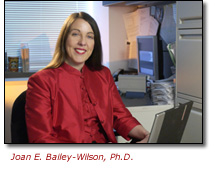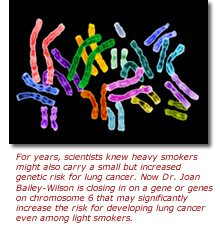Genomics in Action: Joan Bailey-Wilson, Ph.D.
On The Trail Of A Killer Gene
 If lung cancer were a person, it could be profiled on the television show America's Most Wanted. That's because lung cancer is the number one cancer killer in the nation, claiming more lives every year than colorectal, breast, pancreas and prostate cancers combined.
If lung cancer were a person, it could be profiled on the television show America's Most Wanted. That's because lung cancer is the number one cancer killer in the nation, claiming more lives every year than colorectal, breast, pancreas and prostate cancers combined.
Now, Joan Bailey-Wilson, Ph.D., a researcher and senior investigator at the National Human Genome Research Institute (NHGRI), is among a group of scientists who are using genetic clues to track down this elusive culprit.
Despite the best efforts of modern medicine, almost 60 percent of more than 170,000 people diagnosed with lung cancer in the United States in 2005 will die within a year. More than 80 percent will die within five years. The outlook is even worse for those with small-cell lung cancer, a rare, more aggressive form of the disease. Most with small-cell lung cancer die within 18 months of diagnosis.
But unlike law enforcement, where often just a simple sketch can lead to the capture of a criminal, modern medicine requires a detailed description - or at least some knowledge of how a disease starts and progresses - for effective public health interventions. For example, scientists have known for decades that smoking is the leading contributor to the initiation and progression of lung cancer. Yet only 10 to 15 percent of smokers eventually get the disease, leading researchers to suspect that other factors, particularly genetic ones, play a major role.
Dr. Bailey-Wilson, Ph.D. and members of her group at the Inherited Disease Research Branch in NHGRI's Division of Intramural Research are now using the tools and knowledge provided by the recently completed Human Genome Project to identify the "genetic fingerprint" of lung cancer. They are developing innovative statistical methods and software tools to perform the complex analyses of the human genome sequence and other data and help locate disease-associated genes.
Over the past eight years, Dr. Bailey-Wilson's group have been helping members of the Genetic Epidemiology of Lung Cancer Consortium scrutinize the entire human genome in an intensive hunt for the genes that contribute to the development of lung cancer.
In addition to NHGRI participants, the consortium includes: the National Cancer Institute; the Karmanos Cancer Institute, Wayne State University, Detroit; Louisiana State University Health Sciences Center, New Orleans; Mayo Clinic, Rochester, Minn.; Medical College of Ohio, Toledo; Saccomanno Research Institute at St. Mary's Hospital, Grand Junction, Colo.; University of Cincinnati; and University of Colorado Cancer Center, Denver.
With Dr. Bailey-Wilson's help, the consortium recently made huge strides toward understanding the genetic contributions to this disease. "Our work and that of others has identified a number of candidate lung cancer genes that appear to have small effects on lung cancer risk among heavy smokers," said Dr. Bailey-Wilson. "However, we are just now beginning to home in on the location of a gene or genes that appear to significantly increase even light smokers' risk of developing lung cancer."
 Dr. Bailey-Wilson and her collaborators reported strong evidence for the presence of a major lung cancer susceptibility gene on chromosome 6 in a study published in the American Journal of Human Genetics in September 2004. The group also found evidence for the presence of additional lung cancer susceptibility genes on chromosomes 12, 14 and 20, although experimental support for those genes was not nearly as strong as that for the gene on chromosome 6.
Dr. Bailey-Wilson and her collaborators reported strong evidence for the presence of a major lung cancer susceptibility gene on chromosome 6 in a study published in the American Journal of Human Genetics in September 2004. The group also found evidence for the presence of additional lung cancer susceptibility genes on chromosomes 12, 14 and 20, although experimental support for those genes was not nearly as strong as that for the gene on chromosome 6.
One of the consortium's most striking discoveries involved uncovering new insights about the risk of lung cancer among smokers. In smokers who did not have the mutated form of the lung cancer susceptibility gene on chromosome 6, the risk level was directly related to the amount of smoking: the more they smoked, the greater their risk. However, for smokers who did have the mutated form, even small amounts of smoking significantly increased lung cancer risk. These findings suggest that for individuals carrying the aberrant version of the gene, any amount of smoking is particularly dangerous.
"Based on what we know, we predict that the mutated form of the gene or genes on chromosome 6 is rare in the population, but will cause significantly increased lung cancer risk when present. That is much like the situation with the BRCA1 and BRCA2 genes, where the presence of mutated forms of these genes can increase a woman's lifetime risk of breast cancer by about 60 to 80 percent," Dr. Bailey-Wilson said.
Even though consortium members have narrowed the location of the suspect lung cancer gene or genes to a particular segment of a particular chromosome, they still face a monumental task in pinpointing the exact gene and defining the mutations that lead to disease. That is because the identified region is large, spanning about 20 million base pairs of DNA, and is known to contain a number of suspected tumor suppressor genes and other genes that may play a role in cancer.
Faced with this daunting challenge, Dr. Bailey-Wilson and her collaborators are taking a multi-pronged approach to finding the gene - and hoping for a little luck along the way. The first approach is to sequence all of the roughly 100 genes in the identified region of chromosome 6 in lung cancer patients who are predicted to carry the mutated form of the susceptibility gene, as well as healthy people who are not predicted to carry the mutation. To date, this sequencing has been done for over half of the genes, with the remaining genes expected to be sequenced in another six months to a year.
 At the same time, the researchers are pursuing other approaches - and this is where luck may come in - that involve looking for patterns of variation among the genes to see if anything "stands out." Specifically, they are developing what is known as a "dense single-nucleotide polymorphism (SNP) map" of the suspect region. SNPs, which are a common type of genetic variation, occur about once every 1,000 bases along the 3 billion base pairs that make up the human genome.
At the same time, the researchers are pursuing other approaches - and this is where luck may come in - that involve looking for patterns of variation among the genes to see if anything "stands out." Specifically, they are developing what is known as a "dense single-nucleotide polymorphism (SNP) map" of the suspect region. SNPs, which are a common type of genetic variation, occur about once every 1,000 bases along the 3 billion base pairs that make up the human genome.
SNP maps have proven particularly helpful in identifying genes associated with genetically complex diseases, such as cancer, diabetes, vascular disease and some forms of mental illness. Associations between groups of SNPs and a specific disease help point to genes that make a contribution to the disease. To date, consortium members have used their map to identify a number of interesting SNPs in the suspect region. They will next look at the DNA of high-risk lung cancer families to see if there are significant differences in SNP patterns between family members who have developed lung cancer and those who have not. If differences are found, the genomic region harboring those SNPs will be more closely scrutinized.
"If we are lucky, this approach will help us quickly narrow down the region where the culprit gene resides," said Dr. Bailey-Wilson. "We may not be so lucky, but we need to try every tool in our arsenal to find this gene as soon as possible."
When researchers do find the gene- and Dr. Bailey-Wilson has little doubt that the consortium will succeed- they are planning follow-up studies to look at interactions between this gene and other known lung cancer susceptibility genes that have smaller effects. A better understanding of these interactions should help them answer a series of important questions, such as whether a particular genetic profile- or genotype- can predict if someone will get the more deadly, small-cell lung cancer, as opposed to other forms of the disease.
By generating a detailed description of the underlying causes of lung cancer and establishing which genotypes are most contributory, Dr. Bailey-Wilson and colleagues hope to put a complete face on this "most-wanted" killer and, ultimately, improve the odds that at-risk individuals can escape its lethal grip.
"We hope that uncovering a gene or genes that act with smoking to increase the risk for lung cancer will lead to better strategies for treatment and prevention," said Dr. Bailey-Wilson.
Last Reviewed: March 12, 2012






